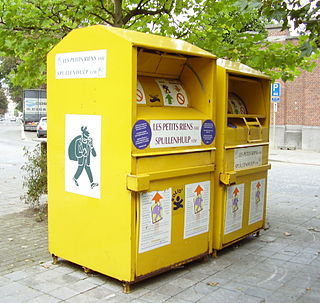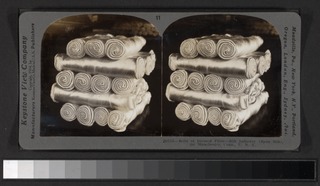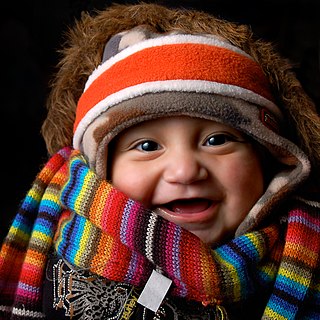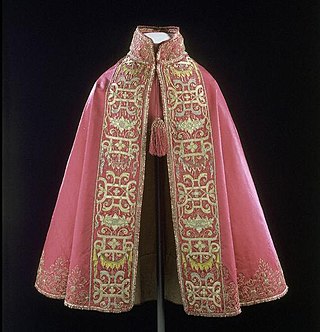Related Research Articles

Textile is an umbrella term that includes various fiber-based materials, including fibers, yarns, filaments, threads, different fabric types, etc. At first, the word "textiles" only referred to woven fabrics. However, weaving is not the only manufacturing method, and many other methods were later developed to form textile structures based on their intended use. Knitting and non-woven are other popular types of fabric manufacturing. In the contemporary world, textiles satisfy the material needs for versatile applications, from simple daily clothing to bulletproof jackets, spacesuits, and doctor's gowns.

Dyeing is the application of dyes or pigments on textile materials such as fibers, yarns, and fabrics with the goal of achieving color with desired color fastness. Dyeing is normally done in a special solution containing dyes and particular chemical material. Dye molecules are fixed to the fiber by absorption, diffusion, or bonding with temperature and time being key controlling factors. The bond between the dye molecule and fiber may be strong or weak, depending on the dye used. Dyeing and printing are different applications; in printing, color is applied to a localized area with desired patterns. In dyeing, it is applied to the entire textile.

"Technical textile" refers to a category of textiles specifically engineered and manufactured to serve functional purposes beyond traditional apparel and home furnishing applications. These textiles are designed with specific performance characteristics and properties, making them suitable for various industrial, medical, automotive, aerospace, and other technical applications. Unlike conventional textiles used for clothing or decoration, technical textiles are optimized to offer qualities such as strength, durability, flame resistance, chemical resistance, moisture management, and other specialized functionalities to meet the specific needs of diverse industries and sectors.

Textile recycling is the process of recovering fiber, yarn, or fabric and reprocessing the material into new, useful products. Textile waste is split into pre-consumer and post-consumer waste and is sorted into five different categories derived from a pyramid model. Textiles can be either reused or mechanically/chemically recycled.
Complete garment knitting is a next-generation form of fully fashioned knitting that adds the capability of making a 3-dimensional full garment. Unlike other fully fashioned knitting, where the shaped pieces must still be sewn together, finished complete knitted garments do not have seams. The knitting machines' computerized instructions direct movement of hundreds of needles to construct and connect several tubular knitted forms to create a complete garment in a single production step.
A staple fiber is a textile fiber of discrete length. The opposite is a filament fiber, which comes in continuous lengths. Staple length is a characteristic fiber length of a sample of staple fibers. It is an essential criterion in yarn spinning, and aids in cohesion and twisting. Compared to synthetic fibers, natural fibers tend to have different and shorter lengths. The quality of natural fibers like cotton is categorized into staple length such as short, medium, long staple, and extra-long. Gossypium barbadense, one of several cotton species, produces extra-long staple fibers. The staple fibers may be obtained from natural and synthetic sources. In the case of synthetics and blends, the filament yarns are cut to a predetermined length.

In textile manufacturing, finishing refers to the processes that convert the woven or knitted cloth into a usable material and more specifically to any process performed after dyeing the yarn or fabric to improve the look, performance, or "hand" (feel) of the finish textile or clothing. The precise meaning depends on context.

Jersey is a knit fabric used predominantly for clothing manufacture. It was originally made of wool, but is now made of wool, cotton and synthetic fibers.

A bolt is a piece of cloth woven on a loom or created by a knitting machine, as it is processed, stored and/or marketed. Consequently, its dimensions are highly variable – flexible and dependent upon the manufacturing, machinery, quantity, size, thickness and quality of the product. It is a unit used in manufacturing, transport and inventory. It is also used as a descriptor for wallpaper, which uses different fabrication machinery. Being encompassing, it is by its nature a generic and ambiguous term of convenience and context, used to describe fabric and wallpaper.

Cut-resistant fabrics are those that can withstand slashing or cutting action. These textile products protect the wearer from accidents and occupational hazards. Metallic materials, Para aramid, high-modulus polyethylene materials and high density structure materials are used in the manufacturing of cut resistant textiles. Cut-resistant fabrics have various applications in mechanical protection for the wearer. They are used for protective wear in aprons and gloves for chefs, military use, the construction industry, forest use in trimming trees, etc
Dimensional stability pertains to a fabric's ability to maintain its initial size and shape even after undergoing wear and care, which is a desirable property. Textile manufacturing is based on the conversion of fiber into yarn, yarn into fabric, includes spinning, weaving, or knitting, etc. The fabric passes through many inevitable changes and mechanical forces during this journey. When the products are immersed in water, the water acts as a relaxing medium, and all stresses and strains are relaxed and the fabric tries to come back to its original state.
Clothtech is a segment of technical textiles that includes all textile components used primarily in clothing and footwear. Clothtech adds functional properties to the product that improve specific and critical objectives. Clothtech encompasses the functional parts that may not be visible, such as zippers, labels, sewing threads, elastics, insulating fiber fills, waddings, shoelaces, and drawcords velcro, and interlining cloths, etc. Sewing threads is the major component that accounts around 60% of the technical textiles under clothtech followed by labels 19%, interlinings 8%, shoelaces and zip fasteners 5%, Velcro and umbrella 2%.

Greige goods are loom state woven fabrics, or unprocessed knitted fabrics. Greige goods undergo many subsequent processes, for instance, dyeing, printing, bleaching, and finishing, prior to further converting to finished goods such as clothing, or other textile products. "Grey fabrics" is another term to refer to unfinished woven or knitted fabrics.

Hand feel is the property of fabrics related to the touch that expresses sensory comfort. It refers to the way fabrics feel against the skin or in the hand and conveys information about the cloth's softness and smoothness. Hand feel is an estimated and subjective property of different fabrics, but nowadays, hand feel could be measured and assessed statistically.

Textile performance, also known as fitness for purpose, is a textile's capacity to withstand various conditions, environments, and hazards, qualifying it for particular uses. The performance of textile products influences their appearance, comfort, durability, and protection. Different textile applications require a different set of performance parameters. As a result, the specifications determine the level of performance of a textile product. Textile testing certifies the product's conformity to buying specification. It describes product manufactured for non-aesthetic purposes, where fitness for purpose is the primary criterion. Engineering of high-performance fabrics presents a unique set of challenges.
Barré is an unintentional repetitive horizontal pattern in fabrics that is generally undesirable and considered as a defect. It appears as a lateral stripe pattern. Barré occurs for many reasons associated with the manufacturing of textile ensembles like fiber, yarn, fabric manufacturing, weaving or knitting, or finishing faults.

Chemical finishing of textiles refers to the process of applying and treating textiles with a variety of chemicals in order to achieve desired functional and aesthetic properties. Chemical finishing of textiles is a part of the textile finishing process where the emphasis is on chemical substances instead of mechanical finishing. Chemical finishing in textiles also known as wet finishing. Chemical finishing adds properties to the treated textiles. Softening of textiles, durable water repellancy and wrinkle free fabric finishes are examples of chemical finishing.

Aesthetics in textiles is one of the basic concepts of serviceability of textiles. It is determined by the perception of touch and sight. Aesthetics imply the appearance and attraction of textile products; it includes the color and texture of the material. It is a statement about the end user (consumer) and the target market. When combined with fabric construction, the finish of the clothing material, garment fit, style, and fashion compatibility, colours create an aesthetic comfort. All of these elements work together to satisfy our visual perception. Aesthetics incorporates the role of evaluation also.

Textile testing is the process of measuring the properties and performance of textile materials—textile testing includes physical and chemical testing of raw materials to finished products.
The London shrunk, or London shrinkage, process was an 18th-century textile finishing process designed to preshrink wool fabrics and minimize their tendency to shrink before being used for making garments. When compared to the traditional steam shrinking method of controlling shrinkage, London shrinkage provided more permanent results in terms of reducing the likelihood of fabric shrinkage. London shrunk was found to be effective for fine worsteds, it was not typically used for woolens.
References
- 1 2 Stout, Evelyn E. (1970). Introduction to textiles. Internet Archive. New York, Wiley. p. 334. ISBN 978-0-471-83097-9.
- ↑ Harder, Frances (2004). Fashion for profit : a professional's complete guide to designing, manufacturing, & marketing a successful line. Internet Archive. Rolling Hills Estate, California USA: Harder Publications. p. 110. ISBN 978-0-9727763-1-8.
- 1 2 truents (2010-10-27). "Fabric Inspection in apparel manufacturing". Textile School. Retrieved 2022-04-06.
- ↑ Kadolph, Sara J. (2007). Textiles. Internet Archive. Upper Saddle River, N.J. : Pearson Prentice Hall. p. 14. ISBN 978-0-13-118769-6.
Keep in mind that fabric quality is not the same thing as product quality. Fabric quality addresses the fabric used to produce the product. Other factors such as design and construction also influence product quality,
- ↑ Kadolph, Sara J. (1998). Textiles. Internet Archive. Upper Saddle River, N.J.: Merrill. pp. 397, 405. ISBN 978-0-13-494592-7.
- ↑ Vijayan, A.; Jadhav, A. (2015-01-01), Nayak, Rajkishore; Padhye, Rajiv (eds.), "5 - Fabric sourcing and selection", Garment Manufacturing Technology, Woodhead Publishing Series in Textiles, Woodhead Publishing, pp. 109–128, ISBN 978-1-78242-232-7 , retrieved 2020-12-25
- ↑ Sarkar, Prasanta. Garment Manufacturing: Processes, Practices and Technology. Online Clothing Study. p. 160. ISBN 978-93-83701-75-9.
- ↑ "Textile Standards". www.astm.org. ASTM . Retrieved 2020-12-29.
- ↑ "7 things you need to know about fabric inspection". 7 things you need to know about fabric inspection. Retrieved 2022-04-06.
- ↑ Mehta, Pradip V.; Bhardwaj, Satish K. (1998). Managing Quality in the Apparel Industry. New Age International. p. 18. ISBN 978-81-224-1166-9.
- ↑ Tsang, Colin S. C.; Ngan, Henry Y. T.; Pang, Grantham K. H. (2016-03-01). "Fabric inspection based on the Elo rating method". Pattern Recognition. 51: 378–394. doi:10.1016/j.patcog.2015.09.022. hdl: 10722/229176 . ISSN 0031-3203.
- ↑ Nayak, Rajkishore; Padhye, Rajiv (2017-11-10). Automation in Garment Manufacturing. Woodhead Publishing. ISBN 978-0-08-101133-1.
- ↑ Jana, Prabir (2013-02-01). "Camera Based Visual Fabric Inspection". Apparel Resources. Retrieved 2020-12-25.
- ↑ News-Desk, Apparel Resources (2018-10-22). "Researchers develop AI based fabric detection system for textile industry | Technology News Hong Kong". Apparel Resources. Retrieved 2020-12-30.
- ↑ Gioello, Debbie Ann (1982). Understanding fabrics : from fiber to finished cloth. Internet Archive. New York: Fairchild Publications. p. 133. ISBN 978-0-87005-377-1.
- ↑ Souza, D. Noemia (1998). Fabric Care. New Age International. p. 116. ISBN 978-81-224-1143-0.